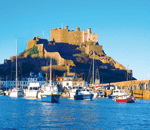
So near and so good!
Fancy an island getaway where you can enjoy beautiful countryside, spectacular coastlines, good food and a wealth of heritage sites? Jackie Stead discovers it’s all just a short flight away – in Jersey
Back in the 1980’s, when the TV series Bergerac was top Saturday night viewing, tourists flocked to the island of Jersey to enjoy the Mediterranean weather and unspoilt beaches. Now, with cheaper flights to more exotic locations, Jersey is working hard to show it still has a lot to offer.
I arrived to glorious sunshine and was soon enjoying a welcome cup of coffee at the Christian–run Highlands Hotel on the west coast of the island, just a 15 minute drive from the airport.
The hotel has 56 en-suite rooms, all decorated and furnished to a high standard and with either sea or country views. There’s a good mix of twin, single and family rooms, with specially adapted rooms for disabled guests on the ground floor. For a bit of extra luxury, choose one of the balcony suites, which allows you to sit outside with your morning coffee overlooking a tiny cove and beautiful sea views - sheer bliss!
Meals at the hotel were excellent, with a good choice at both breakfast and evening meals. Light lunches, homemade cakes and Jersey Cream teas are also available if you are around during the day and on Sundays, a full roast dinner is served at lunch time. Not to be missed is the amazing cold buffet served on Sunday evenings, guaranteed to fill even the biggest appetite.
Established in 1967, when Christian houseparties were very much in vogue, the hotel continues its tradition of offering a varied ministry programme led by invited guest speakers. I didn’t go to the pre-breakfast prayer meetings, but joined in the evening fellowship – a combination of teaching, testimonies, favourite songs and hymns, and quizzes. It proved to be an ideal opportunity to meet other guests, many of whom were regular visitors to the hotel and keen to recommend places to visit.
With limited time, I chose to concentrate on some of the premier attractions and began with the island’s capital and main shopping centre, St Helier. All the famous high street stores are here, plus Jersey’s own boutiques, shops and Victorian market. This is also Jersey’s political centre and, on a busy Saturday, the royal square, where Jersey’s Parliament meets in one of the many attractive period buildings, is a welcome quiet oasis.
Down towards the quay is the tourist office – a good place to pick up information about special events or to book one of the many guided walks around the island. I was there for the Maritime festival so the quay was buzzing with people browsing the market stalls and enjoying the ‘sea shanty singers’ and local performers.
At the centre of the harbour is the Maritime museum, which celebrates Jersey’s long association with the sea. Permanent displays and interactive exhibits tell the story of Jersey’s past as a major shipbuilding centre and explain the tides and currents around the island. (Jersey has one of the largest tidal movements in the world and actually doubles in size when the tide goes out!)
Next door to the museum is the Occupation Tapestry Gallery, where a beautiful worked tapestry tells the story of life in Jersey during the second world war and the German occupation. Its’ 12 panels (one from each of Jersey’s 12 parishes) capture the islanders’ personal memories.
Keen to learn more about the island under occupation, I was told the Jersey War Tunnels in the parish of St Lawrence is a must. The entrance takes you through a 20 foot tunnel, leading to a series of whitewashed rooms, which each tell a story through displays, photographs and interviews with islanders.
First, the decision whether to stay on the island or leave, then life alongside the Germans, the attempts at sabotage and resistance, and the whispering campaign and poison pen letters as islanders betrayed each other. One of the most fascinating rooms showed the ingenuity of people as they struggled to provide for themselves amid increasing shortages of food and other supplies.
Parts of the tunnels have been left unfinished showing the terrible conditions that slave labourers from across Europe endured to build the complex, which was to have sheltered 12,000 Germans and was later converted into an emergency hospital.
It takes between one and two hours to complete the tour and with a constant temperature of between 10-13 C in the tunnels, it can begin to feel chilly. I was certainly ready for a welcome cup of coffee at the café, which also offers a good selection of hot and cold meals if you need more sustenance.
For an insight into Jersey’s earlier history, the Living Legends village is just a few miles further north of the tunnels. Here the Jersey Experience, an award-winning special effects show, tells the story of Jersey and its people in a dramatic presentation featuring the voices of Stephen Tomkinson, John Nettles, Tony Robinson and other well-known actors. Other exhibits reflect Jersey’s heritage, folklore and some of its’ most famous inhabitants.
Designed as a family attraction, the village also includes an 18 hole adventure golf course and go karting complex . A creperie and kitchen restaurant offer a wide-range of tempting meals and snacks and, if you’re looking for gifts to take home, the craft and shopping village has a range of lace and leather goods, jewellery, accessories, china and some of Jersey’s famous fudge!
One place I’d been told not to miss was the Gerald Durrell Wildlife Sanctuary towards the east of the island in the parish of Trinity. Founded by the late Gerald Durrell, it has built up an international reputation for its pioneering conservation techniques. With 31 acres of parkland and water gardens providing a home for exotic and endangered animals, there was certainly lots to see.
Visitors are advised of feeding times for many of the animals and staff give talks on their natural habitats and behaviour. I had hoped to see the wolves, but they were wisely sheltering out of the heat. The meercats, on the other hand, were unfazed by it and were a joy to watch, whilst the baby orang-utang drew lots of oohs and ahs from visiting schoolchildren.
Sadly there wasn’t time to explore Jersey’s varied coastline, which delights walkers with a rugged headland of heather, fern and gorse in the north, the long sandy sweep of St Aubin’s Bay in the South, the rugged cliffs of the west and the dramatic eastern skyline dominated by Mont Orguiel Castle and the backdrop to the islands myths and legends.
Recently reopened after a five year restoration project, the castle was on my ‘must see’ list. It was built in the 13th century after King John lost Normandy to King Philippe Auguste of France and is one of the best preserved castles in Britain. Now, among the labyrinth of stairways and passageways, are 50 new exhibits including the medieval wound man, depicting the various types of battle wounds from a medieval surgeon’s almanac, an insight into life in Tudor times in the Great Hall and (down a dark stairway) a representation of hell in galvanised iron, complete with a fiendishly grinning devil.
It was quite a relief to get back into the open air and take in the splendid views from the castle roof across the royal bay of Grouville.
Then it was across the length of the island to see the golden sandy beaches of St Ouen and to stop in one of Jersey’s specialist retail outlets – Jersey Pearl. Here you can learn all about this precious jewel, watch craftsmen at work, browse the lovely pieces on display and even pick your own pearl and have it set in a piece of jewellery to your own design.
Over coffee and cake at the café there, I browsed through my brochures and realised how much there was still to see and do. Jersey might be a small island, but it offers an amazing range of sites, activities, festivals and events to suit all ages and it has to be one of the friendliest places I’ve ever visited.
Back at Highlands, I spent my last evening walking down to the famous Corbiere Lighthouse just a few minutes away. Thanks to staff at the hotel, I had timed it right to take advantage of the low tide and walk out to the lighthouse. There were just a few people doing the same and it was beautifully quiet.
Ten minutes after my return, the tide started to come in (a siren warns any straying tourists) and I watched the whole walkway slowly disappear beneath the waves as the sky changed from blue to pink and the sun set. It was simply perfect.
Find out more
* For information about holidaying in Jersey , contact Jersey Tourism, Liberation Square, St Helier, Jersey JE1 1BB Tel 01534 500777 www.jersey.com
* For Highlands Hotel, contact them at Rue de la Corbiere, St Brelade, Jersey JE3 8HN Tel: 01534 744288 www.highlandshotel.com
Jersey File
* Jersey is the most southerly of the Channel Islands and has one of the best sunshine records in the British Isles.
* Currency is sterling, although Jersey has its own coins and notes. English money is freely accepted, as are UK cheques supported by a bankers card.
* Getting around the island is a joy. A good bus service offers easy access to all the main attractions and, if you choose to hire a car, you will find Jersey drivers are both courteous and helpful. The island’s speed limit is 40mph, but there are areas of 30 mph and 20 mph, and specially designated Green Lanes (15 mph) where people not cars have priority.
* Jersey is part of the British Isles, but though subject to the Queen, it is not subject to the British Government. The island has its own legislative assembly and manages its own internal affairs through its own parliament, the States of Jersey.






























